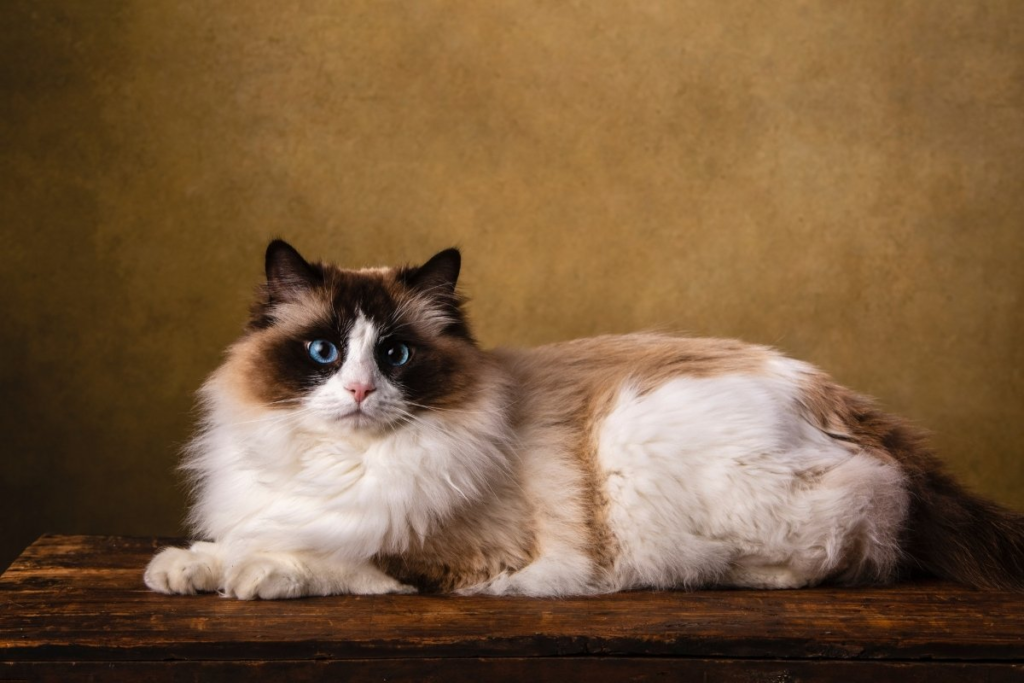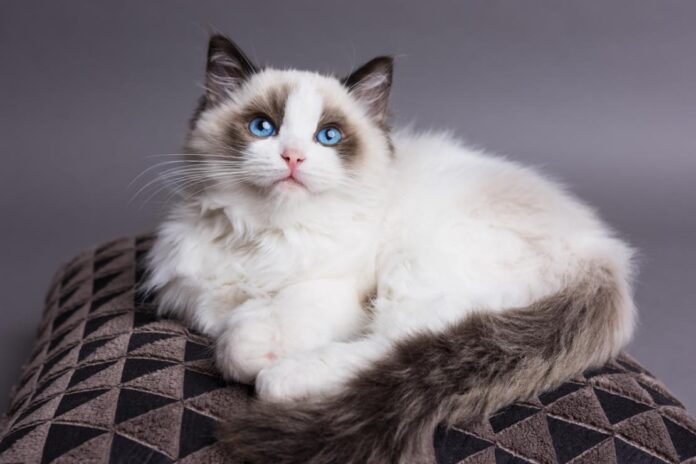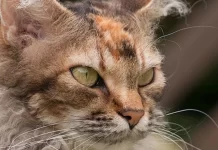Last Updated on August 27, 2023 by Fumipets
Ragdoll Cats: Gentle Giants of the Feline World
Ragdoll cats are renowned for their striking beauty and gentle, affectionate nature. Originating in the United States, this breed’s name reflects their tendency to go limp when picked up, a trait that adds to their endearing charm. Ragdolls are characterized by their large size, stunning blue eyes, and luxurious semi-long fur. Here’s a summary of the captivating features and unique characteristics of Ragdoll cats.
Ragdoll Cats
Ragdoll Cats are big, adorable cats who are very kind and patient. These cats are a peaceful and placid species despite their commanding size, and they like nothing more than snuggling and playing with their owners.
This breed is often very sociable and simple to care for. They are wonderful household pets and get along nicely with young ones. This sweet cat will shower you with unending love and devotion if you are willing to give her your time and attention.
Ragdolls are less popular than other cat breeds because they need careful breeding. Prices for ragdolls may range from $400 for a kitten to $2,000 for a display cat. Your cat’s price will vary depending on its age and pedigree.
Appearance
Large and robust, these stunning cats have long fur and a smooth, silky coat. Ragdolls are a breed with little to no shedding, however in the spring, there may be more shedding than usual. The reason this breed doesn’t shed is because they don’t have an undercoat, yet they are not thought of as “hypoallergenic” cats.
These cats often measure 17 to 21 inches in length (without their fluffy tail) and stand between 9 and 11 inches tall. According to the Cat Fanciers’ Association, ragdoll cats normally weigh more than females and range in weight from 10 to 20 pounds.
There are five different ragdoll coat patterns, according to the Ragdoll Fanciers Club: colorpoint, bicolor, mitted, lynx point, and tortie point.
Colorpoint coats are darker around the eyes, ears, tail, limbs, and (sometimes) stomach.
Bicolor ragdoll cats are similar in appearance to colorpoint ragdolls, but these cats will have an inverted-V coloring pattern on the face with a light belly and limb color.
Mitted ragdolls look like their colorpoint counterparts but have extra light spots near the paws, giving the appearance of mittens.
Lynx point ragdolls look like colorpoints but have tabby markings on their face.
Tortie points also look like colorpoints but incorporate red or cream mixed into other colors
Black, white, gray, blue, cream, lilac, chocolate, seal, and red are some common ragdoll hues. Blue eyes are a well-known trait of this species, however they are not exclusive to ragdolls.

Temperament
As placid as cats get, this lovely breed is. In fact, their propensity to go limp when picked up is where the term “ragdoll” originates. These cats like being cuddled and hugged, and they will unwind in your arms for however long you let them to.
The ragdoll has an intelligent, kind, and very loving demeanor. These gentle cats are affectionate and want human contact, yet they are seldom pushy. Ragdolls are excellent companion animals since they are very dedicated to and loyal to their owners.
Although these “gentle, floppy cats” are often laid-back, Specialty Purebred Cat Rescue director Kirsten Kranz adds that every cat is an individual and it’s vital to do your homework before taking home a kitten, regardless of the breed.
Before making a decision, she advises prospective owners to conduct their research, check references, and connect with the cats of breeders.
You may not hear much from these silent cats when it comes to noise. Unless anything bothers them, ragdolls usually don’t make a lot of noise. When cats do talk, they usually utter short, gentle meows and meeps to communicate their needs, like as hunger or affection.
Your ragdoll cat may not like scaling the highest spots in the home as other cats do. The CFA refers to these cats as “floor cats” because they like to be close to the ground, but they are more than willing to climb up onto a couch or bed to cuddle up next to you.
Living Needs
According to the Ragdoll Fanciers Club, ragdolls are often simple to care for and a suitable match for most families, children, adults, and elders. This breed gets along nicely with other animals as well. They’ll be a lovely addition to your home if you have the room to keep these large cats and plenty of affection to shower on them.
Short periods of time—like a workday—can be spent without your ragdoll, but they will undoubtedly miss you. These cats thrive in homes with at least one family member (or more!) around throughout the day because they seek human interaction. A ragdoll who is constantly left alone at home with her people would undoubtedly get lonely. And when you do go out for a little while, don’t be startled when you return to discover your ragdoll waiting for you at the door!
Keep a close check on your ragdoll who is quite sociable. These cats have been raised to approach people with little caution and to have pleasant, trusting attitudes. Put them on a harness and keep them close if you take them outdoors.
Although docile, ragdolls are not lazy, according to Kranz. Make sure to have enough supply of cat toys, scratching posts, and additional cardboard boxes on hand since these cats like playing and participating in family activities. They are more than eager to unwind in your arms or on your lap for plenty of cuddles after a long day.
Care
The ragdoll has basic grooming requirements. These are highly clean creatures that can take care of the most of their own requirements, although sometimes they may still need to be bathed. Put her in the tub when you see that her coat is slick and stringy.
“Daily combing will keep a ragdoll in good shape,” asserts Nicole Goudey-Rigger, owner and CEO of Pets a Go Go. The secret to avoiding trips to a professional groomer is to start early in a kitten’s life and to set aside a certain amount of time every day.
Additionally, regular pet maintenance for your ragdoll will be required, such as ear cleaning and nail cutting.
Ragdolls are lively creatures that like having toys available to them. Because cats can’t climb very high, cat trees should be close to the ground. This particular breed of cat doesn’t need a lot of additional activity. They will likely spend a lot of time lazing about, perhaps engaging in brief spurts of play or activity interspersed with lengthy naps.
Ragdoll cats are often simple to train. They can pick some interesting skills like retrieving toys when called and coming when called. Additionally, they often learn the fundamentals quickly, including utilizing scratching posts and litter boxes. Speaking of litter boxes, these huge males require large ones so they can fit inside and squat comfortably. These sociable cats benefit greatly from loads of positive reinforcement, treats, and praise when being trained.
A ragdoll is simple to socialize with since it wants to be everyone’s best friend. Keeping a watch on these social butterflies who may get themselves into trouble (or lost, or stolen) while attempting to make friends is the most difficult aspect.
Because ragdoll cats are prone to obesity, feed yours high-quality cat food and keep an eye on her to avoid overeating. To find out how much and how frequently to feed your specific cat, see your veterinarian.

Health
Ragdoll cats are normally healthy pets with a long lifetime of 13 to 18 years.
The most serious health hazards for ragdolls include urinary tract problems and hypertrophic cardiomyopathy (HCM). Reputable breeders will check your kitten for health problems, but it’s crucial to continue screening them until they are adults. HCM and other health issues may not show up in your cat’s early years.
According to Goudey-Rigger, “like all other purebreds, health issues can be more frequent simply due to the smaller gene pool.” Since there is an increase in problems that may be avoided or at least delayed by nutrition and routine veterinarian treatment, it is essential to have a solid working relationship with an expert cat vet.
“A ragdoll will stay in excellent condition with daily brushing. To prevent trips to a professional groomer, starting early in a kitten’s life and dedicating a certain amount of time each day are essential.
History
In Riverside, California, a breeder by the name of Ann Baker created the ragdoll in the 1960s. The soft, non-aggressive characteristics were carefully chosen throughout the ragdoll breeding procedure. As time went on, Baker developed more bizarre theories about the ragdoll breed; at one point, however, she even said that the breed was the consequence of genetically engineered medicine. In 1965, the ragdoll cat was recognized as a purebred.
Due to growing tension with Baker, breeders who were franchised by him finally distanced themselves. However, they persisted in producing the cuddly, obedient cats that are so beloved today.
Q&A: Ragdoll Cats
Q1: What makes Ragdoll cats stand out from other breeds?
Ragdoll cats are known for their large size, striking blue eyes, and semi-long fur that comes in a variety of colors and patterns. Their docile temperament and tendency to go limp when held contribute to their distinctive charm.
Q2: Are Ragdoll cats truly as relaxed as they appear?
Yes, Ragdolls are often described as “gentle giants” due to their laid-back nature. They tend to be friendly, affectionate, and enjoy being held and cuddled. Their calm demeanor makes them well-suited for indoor living.
Q3: How do Ragdoll cats interact with their human families?
Ragdolls form strong bonds with their families and often follow them around the house. They enjoy being involved in daily activities and thrive on companionship, making them excellent companions for households with people or other pets.
Q4: How do I care for a Ragdoll cat’s coat?
Their semi-long fur requires regular grooming to prevent tangles and matting. Brushing a few times a week helps maintain their coat’s health and minimizes shedding.
Q5: Are there any health considerations specific to Ragdoll cats?
Ragdolls are generally healthy cats, but they can be prone to certain genetic conditions such as hypertrophic cardiomyopathy (a heart condition) and bladder issues. Regular veterinary check-ups are crucial for their well-being.
https://www.youtube.com/watch?v=dVg4zgkUriI


















